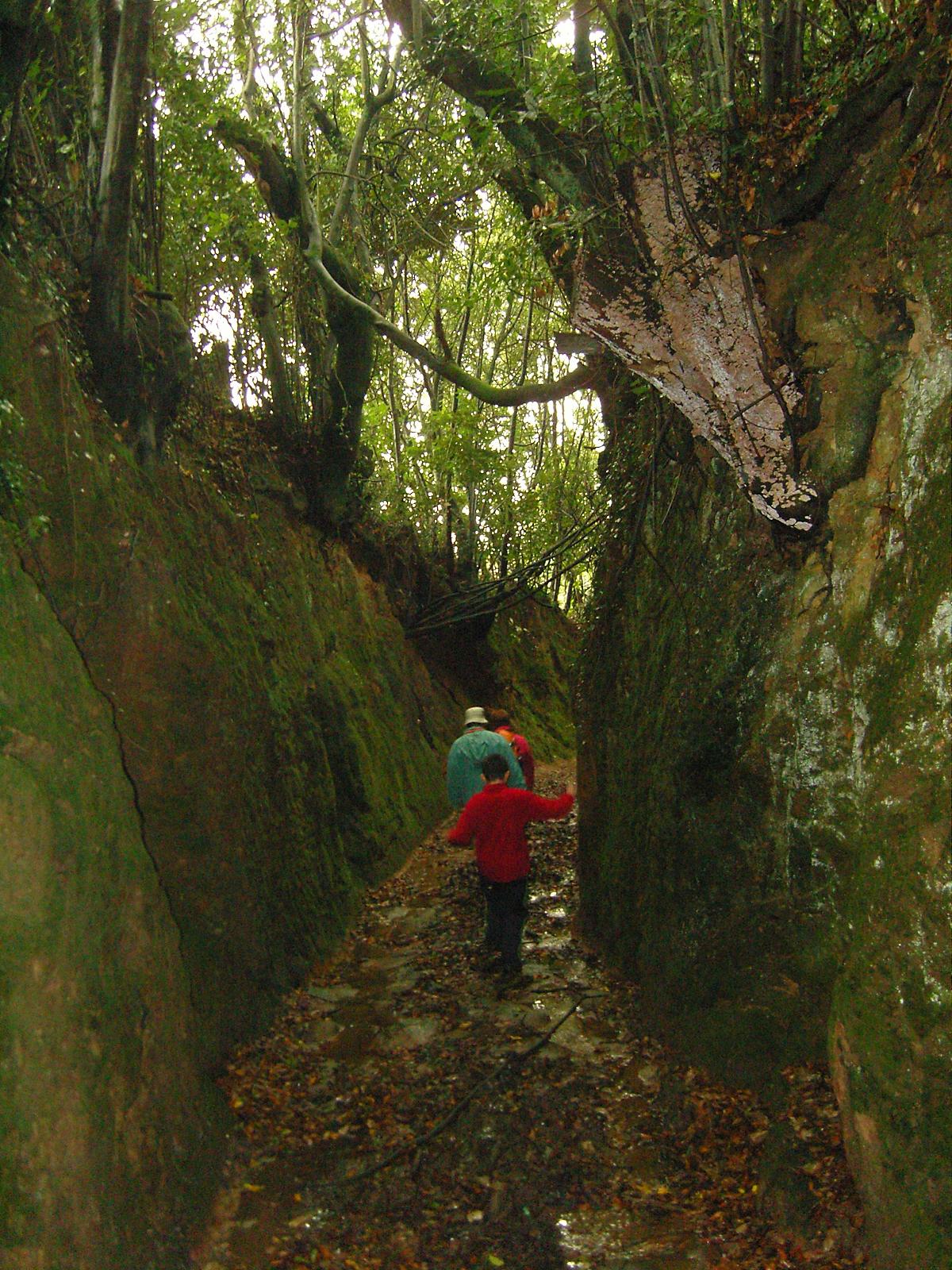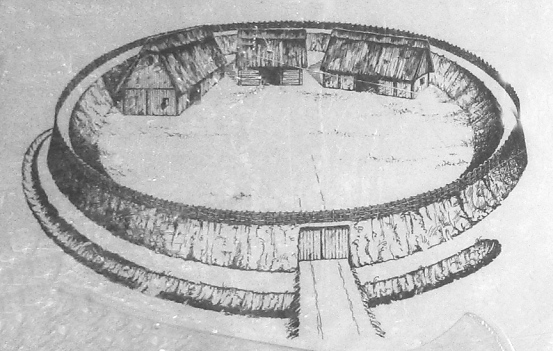|
Pincer Gate
A pincer gate (german: Zangentor) is a gate in a fortification that is deeply embedded between two inward angled exterior walls. Those wishing to enter the fort have to approach what is in effect a sunken road and, if hostile, can be attacked from both side walls in a pincer fashion. Pincer gates were already being used in Urnfield and Celtic fortification in Central Europe and may also be seen in Early Medieval circular ramparts. They were common well into the High Middle Ages. Literature * Horst Wolfgang Böhme, Reinhard Friedrich, Barbara Schock-Werner: ''Wörterbuch der Burgen, Schlösser und Festungen''. Philipp Reclam, Stuttgart, 2004, , pp. 241–242. See also *Chamber gate A chamber gate (german: Kammertor) is a type of gateway system on medieval town fortifications and castles that comprises at least two successive gateways linked by an easily defended passageway between two walls. Chamber gates can be built in the ... {{Fortifications City walls Fortificatio ... [...More Info...] [...Related Items...] OR: [Wikipedia] [Google] [Baidu] |
Fortification
A fortification is a military construction or building designed for the defense of territories in warfare, and is also used to establish rule in a region during peacetime. The term is derived from Latin ''fortis'' ("strong") and ''facere'' ("to make"). From very early history to modern times, defensive walls have often been necessary for cities to survive in an ever-changing world of invasion and conquest. Some settlements in the Indus Valley civilization were the first small cities to be fortified. In ancient Greece, large stone walls had been built in Mycenaean Greece, such as the ancient site of Mycenae (famous for the huge stone blocks of its 'cyclopean' walls). A Greek '' phrourion'' was a fortified collection of buildings used as a military garrison, and is the equivalent of the Roman castellum or English fortress. These constructions mainly served the purpose of a watch tower, to guard certain roads, passes, and borders. Though smaller than a real fortress, they act ... [...More Info...] [...Related Items...] OR: [Wikipedia] [Google] [Baidu] |
Sunken Road
A sunken lane (also hollow way or holloway) is a road or track that is significantly lower than the land on either side, not formed by the (recent) engineering of a road cutting but possibly of much greater age. Various mechanisms have been proposed for how holloways may have been formed, including erosion by water or traffic; the digging of embankments to assist with the herding of livestock; and the digging of double banks to mark the boundaries of estates. All of these mechanisms could apply in different cases. Means of formation A variety of theories have been proposed for the origins of holloways. Different mechanisms may well apply in different cases. Erosion Some sunken lanes are created incrementally by erosion, by water and traffic. Some are very ancient with evidence of Roman or Iron Age origins, but others such as the Deep Hill Ruts in the old Oregon Trail at Guernsey, Wyoming developed in the space of a decade or two. Where ancient trackways have lapsed from us ... [...More Info...] [...Related Items...] OR: [Wikipedia] [Google] [Baidu] |
Urnfield Period
The Urnfield culture ( 1300 BC – 750 BC) was a late Bronze Age Europe, Bronze Age culture of Central Europe, often divided into several local cultures within a broader Urnfield tradition. The name comes from the custom of cremation, cremating the dead and placing their ashes in urns, which were then buried in fields. Over much of Europe, the Urnfield culture followed the Tumulus culture and was succeeded by the Hallstatt culture. Some linguists and archaeologists have associated this culture with the Proto-Celtic language, or a pre-Celtic language family. Chronology It is believed that in some areas, such as in southwestern Germany, the Urnfield culture was in existence around 1200 BC (beginning of Hallstatt A or Ha A), but the Bronze D Riegsee-phase already contains cremations. As the transition from the middle Bronze Age to the Urnfield culture was gradual, there are questions regarding how to define it. The Urnfield culture covers the phases Hallstatt A ... [...More Info...] [...Related Items...] OR: [Wikipedia] [Google] [Baidu] |
Celts
The Celts (, see pronunciation for different usages) or Celtic peoples () are. "CELTS location: Greater Europe time period: Second millennium B.C.E. to present ancestry: Celtic a collection of Indo-European peoples. "The Celts, an ancient Indo-European people, reached the apogee of their influence and territorial expansion during the 4th century bc, extending across the length of Europe from Britain to Asia Minor."; . " e Celts, were Indo-Europeans, a fact that explains a certain compatibility between Celtic, Roman, and Germanic mythology."; . "The Celts and Germans were two Indo-European groups whose civilizations had some common characteristics."; . "Celts and Germans were of course derived from the same Indo-European stock."; . "Celt, also spelled Kelt, Latin Celta, plural Celtae, a member of an early Indo-European people who from the 2nd millennium bce to the 1st century bce spread over much of Europe."; in Europe and Anatolia, identified by their use of Celtic langua ... [...More Info...] [...Related Items...] OR: [Wikipedia] [Google] [Baidu] |
Early Medieval
The Early Middle Ages (or early medieval period), sometimes controversially referred to as the Dark Ages, is typically regarded by historians as lasting from the late 5th or early 6th century to the 10th century. They marked the start of the Middle Ages of European history, following the decline of the Western Roman Empire, and preceding the High Middle Ages ( 11th to 13th centuries). The alternative term ''late antiquity'', for the early part of the period, emphasizes elements of continuity with the Roman Empire, while ''Early Middle Ages'' is used to emphasize developments characteristic of the earlier medieval period. The period saw a continuation of trends evident since late classical antiquity, including population decline, especially in urban centres, a decline of trade, a small rise in average temperatures in the North Atlantic region and increased migration. In the 19th century the Early Middle Ages were often labelled the ''Dark Ages'', a characterization based on t ... [...More Info...] [...Related Items...] OR: [Wikipedia] [Google] [Baidu] |
Circular Rampart
A circular rampart (German: ''Ringwall'') is an embankment built in the shape of a circle that was used as part of the defences for a military fortification, hill fort or refuge, or was built for religious purposes or as a place of gathering. The period during which these structures were built ranged from the Neolithic to the Middle Ages. Construction The key feature of a circular rampart is that the embankment formed the primary element of the defensive fortification. It can be constructed in various ways: as a simple earth embankment, as a wood and earth structure, or as a wall. Circular ramparts usually have a moat or ditch in front of them; the embankment can be enhanced with a wooden palisade. Often several concentric rings were built, which produced a more effective defensive position against attackers. The interior of such sites often shows evidence of buildings such as halls, barns, and other secondary structures. Locations Circular ramparts are found in north and we ... [...More Info...] [...Related Items...] OR: [Wikipedia] [Google] [Baidu] |
High Middle Ages
The High Middle Ages, or High Medieval Period, was the periodization, period of European history that lasted from AD 1000 to 1300. The High Middle Ages were preceded by the Early Middle Ages and were followed by the Late Middle Ages, which ended around AD 1500 (by historiography, historiographical convention). Key historical trends of the High Middle Ages include the medieval demography, rapidly increasing population of Europe, which brought about great social and political change from the preceding era, and the Renaissance of the 12th century, including the first developments of rural exodus and urbanization. By 1250, the robust population increase had greatly benefited the European economy, which reached levels that would not be seen again in some areas until the 19th century. That trend faltered during the Late Middle Ages because of a Crisis of the Late Middle Ages, series of calamities, most notably the Black Death, but also numerous wars as well as economic stagnation. Fro ... [...More Info...] [...Related Items...] OR: [Wikipedia] [Google] [Baidu] |
Horst Wolfgang Böhme
Horst Wolfgang Böhme (born May 1, 1940 in Szczecin) is a German archaeologist with a focus on Late Antiquity / Early Middle Ages and research into castles. Life Böhme studied prehistory, Roman provincial archaeology, history and folklore in Kiel, Mainz and Munich. In 1968 he completed a doctorate on Germanic grave finds from the 4th to the 5th century between the lower Elbe and Loire. In 1970 he was head of department at the Germanisches Nationalmuseum in Nuremberg, then in 1972 assistant and later director of the Early Medieval Department of the Romano-Germanic Central Museum (Mainz). With the large Salian dynasty exhibition in 1991 Böhme went into medieval archeology. The then resulting anthologies to rural settlements and castles gave impetus to the research. From 1992 until his retirement in 2005 he was a professor of ancient history and medieval archeology at the University of Marburg. Böhme is a member of the German Archaeological Institute and the Scientific Advisor ... [...More Info...] [...Related Items...] OR: [Wikipedia] [Google] [Baidu] |
Barbara Schock-Werner
Barbara Schock-Werner (born 23 July 1947, Ludwigsburg) is a German architect, and was until her retirement end of August 2012 the master builder at Cologne Cathedral with overall responsibility for conservation and restoration work. With the official title of ''Dombaumeisterin'' (cathedral master builder), she was the first and only woman to hold the position in the cathedral's 800 years history."Dombaumeisterin Barbara Schock-Werner erhält Verdienstorden des Landes Nordrhein-Westfalen" , ''Der Kölner Dom'', 8 April 2011. Retrieved 11 February 2012. Biography After an apprenticeship as a draftsman in |






